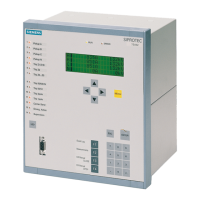2.15 Automatic Reclosure Function (optional)
287
7SD5 Manual
C53000-G1176-C169-1
If, however, the signal transmission is switched off or the transmission path is dis-
turbed, the internal automatic reclosure circuit can determine whether the overreach-
ing zone (Z1B in the distance protection) is released for fast tripping. If no reclosure is
expected (e.g. circuit breaker not ready) the normal grading of the distance protection
(i.e. fast tripping only for faults in zone Z1) must apply to retain selectivity.
However, fast tripping of the protection may also be desired before reclosure after trip-
ping by other short-circuit protection functions. For this purpose, every short-circuit
protection which can start the automatic reclosure function has the possibility of initi-
ating non-delayed tripping in at least one stage when the automatic reclosure function
is ready for the first reclosure cycle. Please note, however, that fast, non-selective trip-
ping should be avoided as long as the differential protection works properly: there
should be no non-delayed tripping of the distance protection as the second main pro-
tection function, even if there is an automatic reclosure.
Fast tripping before reclosure is also possible with multiple reclosures. Appropriate
links between the output signals (e.g. 2nd reclosure ready: „AR 2.CycZoneRel“)
and the inputs for enabling/releasing non-delayed tripping of the protection functions
can be established via the binary inputs and outputs or the integrated user-definable
logic functions (CFC).
Mixed Lines Over-
head Line/Cable
In the distance protection, it is possible to use the distance zone signals to distinguish
between cable and overhead line faults to a certain extent. The automatic reclosure
circuit can then be blocked by appropriate signals generated by means of the user-
programmable logic functions (CFC) if there is a fault in the cable section.
Initiation Starting the automatic reclosure function means storing the first trip signal during a
network fault that was generated by a protection function which operates with the au-
tomatic reclose function. In case of multiple reclosure, initiation therefore only takes
place once, with the first trip command. The detection of the actual circuit breaker po-
sition is necessary for the correct functionality of the auto reclose function.
Starting is important when the first trip command has not appeared before expiry of an
action time (see below under „Action times“).
Automatic reclosure is not started if the circuit breaker has not been ready for at least
one TRIP–CLOSE–TRIP–cycle at the instant of the first trip command. This can be
achieved by setting parameters. For further information, please refer to „Interrogation
of Circuit Breaker Ready State“.
Each short-circuit protection function can be parameterized as to whether it should
operate with the automatic reclose function or not, i.e. whether it should start the
reclose function or not. The same goes for external trip commands applied via binary
input and/or the trip commands generated by the teleprotection via permissive or in-
tertrip signals.
Those protection and monitoring functions in the device which do not respond to short-
circuits or similar conditions (e.g. an overload protection) do not initiate the automatic
reclosure function because a reclosure will be of no use here. The breaker failure pro-
tection must not start the auto-reclosure either.
Action Times It is often desirable to remove the ready-for-reclosure-state if the short-circuit condition
was sustained for a certain time, e.g. because it is assumed that the arc has burned
in to such an extent that there is no longer any chance of automatic arc extinction
during the reclose dead time. Also for the sake of selectivity (see above), faults that
are usually cleared after a time delay should not lead to reclosure. It is therefore rec-
ommended to use action times in conjunction with the distance protection.
www . ElectricalPartManuals . com
